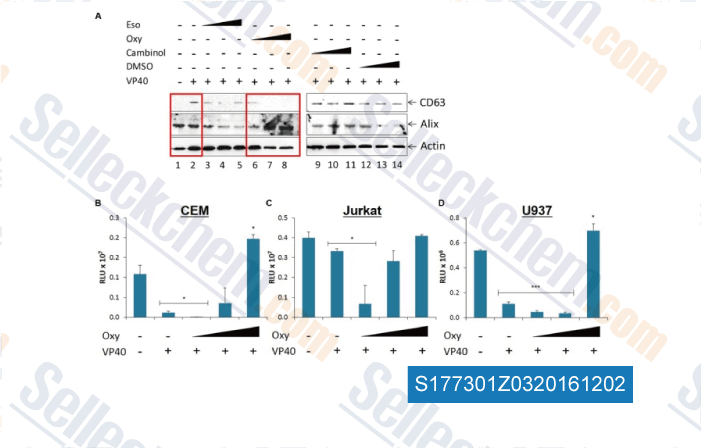|
How to Cite 1. For In-Text Citation (Materials & Methods): 2. For Key Resources Table: |
||
|
Toll Free: (877) 796-6397 -- USA and Canada only -- |
Fax: +1-832-582-8590 Orders: +1-832-582-8158 |
Tech Support: +1-832-582-8158 Ext:3 Please provide your Order Number in the email. We strive to reply to |
Technical Data
| Formula | C22H24N2O9 |
|||
| Molecular Weight | 460.43 | CAS No. | 79-57-2 | |
| Solubility (25°C)* | In vitro | DMSO | 92 mg/mL (199.81 mM) | |
| Ethanol | 10 mg/mL (21.71 mM) | |||
| Water | Insoluble | |||
|
* <1 mg/ml means slightly soluble or insoluble. * Please note that Selleck tests the solubility of all compounds in-house, and the actual solubility may differ slightly from published values. This is normal and is due to slight batch-to-batch variations. * Room temperature shipping (Stability testing shows this product can be shipped without any cooling measures.) |
||||
Preparing Stock Solutions
Biological Activity
| Description | Oxytetracycline (Terramycin) is a broad-spectrum tetracycline antibiotic used to treat infections with bacteria. |
|---|---|
| In vivo | Oxytetracycline (Terramycin) (200 mg/kg for 15 days) results a significant elevation in serum hepatospecific markers such as aspartate transaminase, alanine transaminase, alkaline phosphatase, lactate dehydrogenase, and bilirubin and the levels of lipid peroxidation markers (thiobarbituric acid reactive substances (TBARS) and lipid hydroperoxides) in rat liver. This compound also causes a significant reduction in the activities of superoxide dismutase, catalase, glutathione peroxidase, reduced glutathione (GSH), vitamin C and vitamin E in rat liver. When combined with Naringenin (50 mg/kg b.w.t.), it significantly decreases the activities of serum aspartate transaminase, alanine transaminase, alkaline phosphatase, lactate dehydrogenase and the levels of bilirubin along with significant decrease in the levels of lipid peroxidation markers in the rat liver. [1] Administered orally at 200 mg/kg for 15 days, it produces hepatic damage as manifested by a significant increase in serum hepatic markers namely aspartate transaminase (AST), alanine transaminase (ALT), alkaline phosphatase (ALP), lactate dehydrogenase (LDH), bilirubin and increases plasma and hepatic lipid peroxidation indices (TBARS and hydroperoxide) in rats. It also significantly decreases the levels of enzymatic antioxidants namely superoxide dismutase (SOD), catalase (CAT) and glutathione peroxidase (GPx). [2] |
Protocol (from reference)
References
|
Customer Product Validation

-
Data from [ , , Front Microbiol, 2016, 7: 1765. ]
Selleck's Oxytetracycline (Terramycin) Has Been Cited by 2 Publications
| Antiretroviral Drugs Alter the Content of Extracellular Vesicles from HIV-1-Infected Cells [ Sci Rep, 2018, 8(1):7653] | PubMed: 29769566 |
| Ebola VP40 in Exosomes Can Cause Immune Cell Dysfunction. [Pleet ML, et al. Front Microbiol, 2016, 7: 1765] | PubMed: 27872619 |
RETURN POLICY
Selleck Chemical’s Unconditional Return Policy ensures a smooth online shopping experience for our customers. If you are in any way unsatisfied with your purchase, you may return any item(s) within 7 days of receiving it. In the event of product quality issues, either protocol related or product related problems, you may return any item(s) within 365 days from the original purchase date. Please follow the instructions below when returning products.
SHIPPING AND STORAGE
Selleck products are transported at room temperature. If you receive the product at room temperature, please rest assured, the Selleck Quality Inspection Department has conducted experiments to verify that the normal temperature placement of one month will not affect the biological activity of powder products. After collecting, please store the product according to the requirements described in the datasheet. Most Selleck products are stable under the recommended conditions.
NOT FOR HUMAN, VETERINARY DIAGNOSTIC OR THERAPEUTIC USE.
